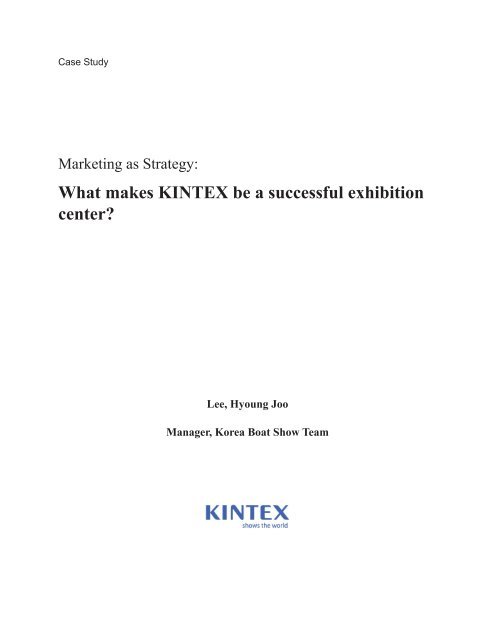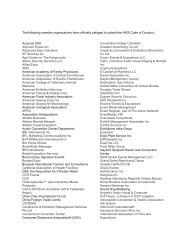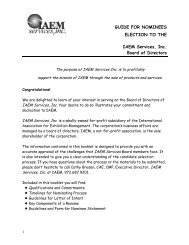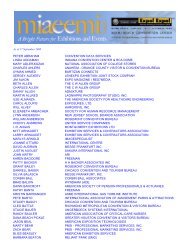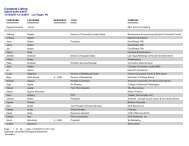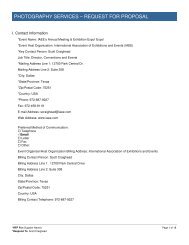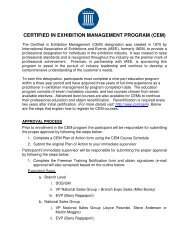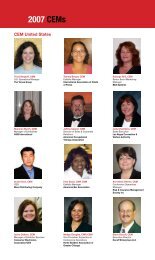What makes KINTEX be a successful exhibition center? - IAEE
What makes KINTEX be a successful exhibition center? - IAEE
What makes KINTEX be a successful exhibition center? - IAEE
You also want an ePaper? Increase the reach of your titles
YUMPU automatically turns print PDFs into web optimized ePapers that Google loves.
Case Study<br />
Marketing as Strategy:<br />
<strong>What</strong> <strong>makes</strong> <strong>KINTEX</strong> <strong>be</strong> a <strong>successful</strong> <strong>exhibition</strong><br />
<strong>center</strong>?<br />
Lee, Hyoung Joo<br />
Manager, Korea Boat Show Team
Executive Summary<br />
This case study shows how <strong>KINTEX</strong> has achieved its success through marketing activities just for 3 years after its opening.<br />
Traditionally 4p (product, pricing, place and promotion) was regarded as useful tactics for implementing marketing activities.<br />
However, 4p was very limited to short-term based marketing strategies and also it is not focused on customer’s value but<br />
provider’s products and services. Therefore, this case study used Dr. Kumar’s 3 Values management model. Dr. Kumar, a<br />
marketing professor of London Business School, proposed that marketing should <strong>be</strong> on CEO’s top agenda. So marketing<br />
should focus on strategic segment, providing solution, market-driving, and corporate marketing. This could <strong>be</strong> achievable<br />
through developing 3 Values – Valued Customers, Value Proposition and Value Network. So the <strong>KINTEX</strong> case is based on<br />
Dr. Kumar’s 3Vs model.<br />
1. Valued Customer – Who to serve?<br />
Big 7 show organizers<br />
<strong>KINTEX</strong> did not target every customer <strong>be</strong>cause <strong>KINTEX</strong> knew that it needs different segmentation based on valued<br />
customers. <strong>KINTEX</strong> targeted <strong>exhibition</strong>s over 20,000m 2 and discussed with key organizers- Korea Machinery Fair, Korea<br />
Electronics Show, Seoul Food Show, Seoul Motor Show, Seoul International Machine Tool Show, Kyunghyang Housing Fair<br />
and G-Star Game Show.<br />
Governments<br />
<strong>KINTEX</strong> was invested by 3 national and local Korean governments – KOTRA (Korea Trade & Promotion Agency),<br />
Gyeonggi province and Goyang city. So these 3 investors are stakeholders and customers as well. KOTRA wants <strong>KINTEX</strong> to<br />
develop international <strong>exhibition</strong>s also <strong>KINTEX</strong> needs KOTRA to attract more overseas buyers and investors to tradeshows.<br />
Gyeonggi province is the biggest local government in Korea so it needs to attract many firms to its area, which let tradeshows<br />
and conference <strong>be</strong> more important. Goyang city provided its land space to <strong>KINTEX</strong> <strong>be</strong>cause it needs international <strong>exhibition</strong><br />
<strong>center</strong> for positioning one of global cities worldwide.<br />
2. Value Proposition – <strong>What</strong> to offer?<br />
Co-location of similar-purposed <strong>exhibition</strong>s<br />
The offerings to target customer reveals differences <strong>be</strong>tween other competitors. <strong>KINTEX</strong> could co-locate similar purposed<br />
<strong>exhibition</strong>s and also gather related <strong>exhibition</strong>s and conventions for making synergy effects. For example, <strong>KINTEX</strong> used<br />
co-locating marketing policies for attracting the Seoul Food Show. <strong>KINTEX</strong> recognized that foods should <strong>be</strong> related with<br />
packaging technology for saving and selling in markets. Therefore, <strong>KINTEX</strong> proposed the co-locating <strong>exhibition</strong> to Food<br />
show organizer and packaging show organizer altogether. The show was great success and it suggested new paradigm of food<br />
and packaging industry.<br />
CMS – Customer Management System<br />
<strong>KINTEX</strong> created CS (Customer Service) team in 2005. CS management was a new activity that other <strong>exhibition</strong> <strong>center</strong>s<br />
never offered to customers. <strong>KINTEX</strong> received the award from Korea Management Association in 2007 through the activities.
3. Value Network – How to deliver?<br />
Firstly it achieved operations efficiency through strategic alliances with <strong>exhibition</strong> partners and evaluation system based on<br />
BSC management model. Second, <strong>KINTEX</strong> has very flexible pricing policies called value pricing based on customers’ value.<br />
For example, it has seasonal package program so that customers can lease space with relatively low prices in summer or<br />
winter season. Third, salesperson meets customers as a consultant. Venue sales and marketing are different compared to other<br />
product sales. Actually sales person should know whole process of customers’ events <strong>be</strong>cause it needs very special technical<br />
and <strong>exhibition</strong> knowledge when supporting customers. It means that marketing person should solve the customer’s problem<br />
from its start to finish. Therefore, customers can get valuable service as shows go on.<br />
4. Conclusion<br />
As <strong>exhibition</strong> industry grows with valuable customers, it should <strong>be</strong> related to hospitality industry including <strong>exhibition</strong>s,<br />
conventions, events, hotel and tourism. These businesses should <strong>be</strong> integrated in <strong>KINTEX</strong> business model for the 2 nd phase of<br />
construction. Valuable customers will require much more <strong>exhibition</strong> services which are different with other venues. <strong>KINTEX</strong><br />
should go for hospitality industry, which means that integrated show businesses will <strong>be</strong> the key competitive advantages and<br />
it can lead <strong>KINTEX</strong> for the market-driving company, not for the market-driven company. However, if CEO has no will or<br />
intention to go for it, it is impossible and no one gets the advantage. Therefore, marketing strategy should <strong>be</strong> a CEO’s top<br />
agenda, and CMO should take a role for leading the strategy.<br />
ii
Table of Contents<br />
I. Introduction........................................................................................................................1<br />
II.<br />
III.<br />
IV.<br />
Marketing as Strategy........................................................................................................3<br />
1. Overview.................................................................................................................................................................. 3<br />
2. Concept and Definition............................................................................................................................................ 4<br />
Case Study: <strong>KINTEX</strong>.........................................................................................................9<br />
1. History..................................................................................................................................................................... 9<br />
2. <strong>KINTEX</strong>’s 3Vs...................................................................................................................................................... 11<br />
(1) Valued Customer – Who to serve?.......................................................................................................... 11<br />
(2) Value Proposition – <strong>What</strong> to offer?......................................................................................................... 14<br />
(3) Value Network – How to deliver?........................................................................................................... 17<br />
3. Strategic and Organizational Challenges............................................................................................................... 19<br />
Conclusions.......................................................................................................................21<br />
References.....................................................................................................................................22<br />
iii
List of Tables<br />
Table III-1. Exhibition facilities in Asia...................................................................................................................................... 16<br />
List of Figures<br />
Figure II-1. The Four P components of the Marketing Mix.......................................................................................................... 3<br />
Figure II-2. The CEO’s Marketing Manifesto............................................................................................................................... 4<br />
Figure II-3. Firm’s growth move from 3Vs questions................................................................................................................... 6<br />
Figure II-4. Solution-Selling Matrix.............................................................................................................................................. 7<br />
Figure II-5. Types of Strategic Innovation.................................................................................................................................... 8<br />
Figure III-1. <strong>KINTEX</strong> views......................................................................................................................................................... 9<br />
Figure III-2. Average <strong>exhibition</strong> spaces....................................................................................................................................... 10<br />
Figure III-3. Conventions in <strong>KINTEX</strong>........................................................................................................................................ 10<br />
Figure III-4. Big 7 shows in Korea.............................................................................................................................................. 12<br />
Figure III-5. SIMTOS <strong>exhibition</strong> plan by 2010........................................................................................................................... 12<br />
Figure III-6. <strong>KINTEX</strong>’s Valued Customer.................................................................................................................................. 13<br />
Figure III-7. Value Proposition – Co-location Strategy............................................................................................................... 14<br />
Figure III-8. <strong>KINTEX</strong> Customer Management System.............................................................................................................. 15<br />
Figure III-9. <strong>KINTEX</strong> Floor plan................................................................................................................................................ 16<br />
Figure III-10. <strong>KINTEX</strong> Strategy Map......................................................................................................................................... 17<br />
Figure III-11. Lease Process for Exhibition Hall........................................................................................................................ 18<br />
Figure III-12. From selling products to providing <strong>exhibition</strong>s.................................................................................................... 19<br />
Figure III-13. <strong>KINTEX</strong>’s New Value Proposition....................................................................................................................... 20<br />
iv
I. Introduction<br />
Korea is one of biggest trading countries ranked 11 th in global market. But the <strong>exhibition</strong> and convention businesses are<br />
still <strong>be</strong>hind the global players. As an <strong>exhibition</strong> is a market place for trades and businesses, it is very important to develop<br />
Korean <strong>exhibition</strong> industry. <strong>KINTEX</strong> (Korea International Exhibition Center) was originally established for the development<br />
of <strong>exhibition</strong> industry in Korea by national and local governments. It is the largest <strong>exhibition</strong> <strong>center</strong> having 54,000m 2 of<br />
<strong>exhibition</strong> spaces in Korea, and also it is one of the most cutting-edge <strong>exhibition</strong> <strong>center</strong>s in Asia. Furthermore, it will <strong>be</strong><br />
doubled in <strong>exhibition</strong> spaces up to 100,000m 2 by 2011. Since its opening at April 2005, it has <strong>be</strong>en dramatically accomplished<br />
a <strong>successful</strong> story in the <strong>exhibition</strong> business. The change occurred by it has not only affected to the <strong>exhibition</strong> business but<br />
also to the local governments who in charge of destination marketing in terms of hospitality industry.<br />
Therefore, it is very important to analyze how <strong>KINTEX</strong> made a <strong>successful</strong> story <strong>be</strong>cause there were no case studies for<br />
analyzing <strong>exhibition</strong> <strong>center</strong>s in terms of marketing management. So this project would <strong>be</strong> the first business case study which<br />
is focused on an <strong>exhibition</strong> industry in Korea. This study will <strong>be</strong> analyzed based on the Professor Kumar’s 3Vs marketing<br />
management model. Below questions are core topics which used for analyzing this case study.<br />
Research Questions<br />
1. Marketing Strategies and executions in terms of Dr. Kumar’s 3Vs<br />
(1) Today’s marketers face a dire situation. CEOs name marketing challenges such as retaining customers<br />
and avoiding price wars as top priorities, yet they increasingly doubt whether marketers can handle those<br />
challenges. Also marketing is now considered a cost sink. Nirmalya Kumar, a professor of London Business<br />
School, outlines four organization- wide transformation initiatives that will win marketing a prominent<br />
seat at the executive table. Kumar shows how a focus on the “three Vs”-the valued customer, the value<br />
proposition, and the value network-can help marketers lead the shift;<br />
- From tactical market segments to strategic segments that enable deep differentiation<br />
- From selling commodity products to providing customers solutions<br />
- From incremental innovation spawned by market research to market-driving innovation spawned by<br />
radical new ones<br />
- From tactical SBU-level marketing to strategic corporate marketing<br />
Kumar’s 3Vs approach is very clear to define the components of success in marketing management <strong>be</strong>cause it shows definite<br />
target and proposition in terms of customer’s value, not provider’s focus.<br />
(2) 3Vs<br />
1) Valued Customer: Who is the target customer?<br />
- Who is the valued customer? In contrast to other <strong>exhibition</strong> <strong>center</strong>s, <strong>KINTEX</strong>’s valued customers are<br />
limited to big 7 show organizers who use it as their show places such as Seoul Motor Show, Food<br />
Show, Housing Fair, etc. Also national and local governments are very valuable customers <strong>be</strong>cause<br />
they provide many business opportunities to <strong>KINTEX</strong> for hosting public and governments-related<br />
<strong>exhibition</strong>s and conventions.<br />
2) Value Proposition: <strong>What</strong> to offer?<br />
- Value proposition, or what to offer to the valued customers shows the distinctive differences <strong>be</strong>tween<br />
the two segments. <strong>KINTEX</strong> could just provide <strong>exhibition</strong> spaces for attracting many trade shows,<br />
convention and other various events. However, it provides valuable offerings such as <strong>exhibition</strong><br />
packages; co-location of similar purposed trade shows. So this brings many positive effects to trade<br />
shows and show organizers as well. Buyers or visitors can look around their interested products,
technologies and related exhibitors in one place. Also exhibitors can show their exhibits to much<br />
more expanded potential customers. This result let exhibitors consider these trade shows must-have<br />
marketing activities.<br />
3) Value Network: How to deliver?<br />
- Value network or how to deliver the value proposition to the valued customer compromises the process<br />
of distribution and operation. It reveals some kinds of process including purchasing, operations and<br />
distribution system. For example, <strong>KINTEX</strong> provides various pricing policies based on customer’s<br />
needs, which includes seasonal packages, multi-year contract discounts, and incentives for co-location<br />
of similar <strong>exhibition</strong>s. Moreover, it handles BSC performance management system so that marketers<br />
can monitor their marketing activities based on performance related KPIs.<br />
2. Strategic and organizational challenges for the next step of <strong>KINTEX</strong><br />
In this question, 3 challenges will <strong>be</strong> reviewed for the development.<br />
(1) From selling products to providing solutions<br />
(2) From market-driven to market-driving<br />
(3) From strategic business unit marketing to corporate marketing<br />
In order to find an appropriate process for analysis, basic theory would <strong>be</strong> firstly reviewed, and then <strong>KINTEX</strong> case study followed.
1. Overview<br />
II. Marketing as Strategy<br />
Marketing’s traditional goal is to get closer to customers. So we usually think that marketing should make a role for<br />
sustaining customers using 4Ps: product, price, place and promotion. The particular marketing variables under each P are<br />
shown in Figure II-1. Marketing-mix decisions must <strong>be</strong> made for influencing the trade channels as well as final customers.<br />
But in most cases, marketing is regarded as a critical expenditure. Once viewed as cost sink, marketing can not do a<br />
prominent role in their organizations. In the Practice of Management, however, Peter Drucker wrote, “The business enterprise<br />
has two and only two basic functions: marketing and innovation. Marketing and innovation produce results; all the rest are<br />
costs.” 1 Nirmalya Kumar, a professor of marketing at London Business School, has <strong>be</strong>en developed the marketing theory<br />
as a corporate strategy for making marketing as a CEO’s top agenda. Actually Kumar introduces a framework for analyzing<br />
and planning marketing strategy in terms of the “three Vs”: valued customer, value proposition, and value network. Kumar<br />
proposes ways to deal with growing commoditization, price pressure, and the increasing market power of global mega<br />
retailers. Also he strives to show how the marketing discipline could “<strong>be</strong>come more strategic, cross-functional, and bottomline<br />
oriented” than ever <strong>be</strong>fore.<br />
Figure II-1. The Four P components of the Marketing Mix<br />
Source: Philip Kotler, Marketing Management (Pearson Education, 2007)<br />
1 Drucker Peter F. (1954) The Practice of Management. New York, Harper Collins
2. Concept and Definition<br />
Marketing as a transformational engine<br />
The main stream of Dr. Kumar’s theory is that marketing should <strong>be</strong> on CEO’s top agenda. For marketers to capture the<br />
imagination of their CEOs, Dr. Kumar reveals that they must break from the tactical four Ps and associate instead with<br />
organization-wide transformational initiatives worthy of the CEO’s agenda. Only initiatives that are strategic, crossfunctional,<br />
and bottom-line oriented will attract the CEO’s attention, and only by leading such initiatives will marketers<br />
elevate their role in the organization. Therefore, transformational marketing efforts should focus on initiatives that<br />
• Profitably deliver value to customers;<br />
• Require high level of marketing expertise;<br />
• Need cross-functional orchestration for <strong>successful</strong> implementation; and<br />
• Are results-oriented.<br />
So these marketing initiatives must have a substantial, demonstrated, top- or bottom-line effect to excite the CEO.<br />
Figure II-2 divides the CEO’s marketing manifesto into four organization-wide transformational initiatives that marketer could lead.<br />
Figure II-2. The CEO’s Marketing Manifesto<br />
Source: Kumar, Nirmalya (2004) Marketing as a Strategy. Boston: HBS Press 2004
(1) From Market Segments to Strategic Segments<br />
Traditionally, marketing has relied on market segmentation and marketing mix to create differentiation. Market segmentation<br />
is the process of dividing marketing mix into clusters of customers in such a way that each market segment is <strong>be</strong>st reached<br />
through a unique marketing mix of the four 4Ps. However, market segments through 4Ps are too limiting. So the strategic<br />
segments divided by the three Vs are recommended.<br />
1) Valued Customer – Who to Serve?<br />
Valued customers are main targets for companies. Traditionally firms categorized customers into general ways using market<br />
segmentations such as ages, sex, and other related cultures. But valued customers are core targets segmented by corporate<br />
strategy. So firms focus on these customers and their marketing strategy is definitely concentrated on these targets. For<br />
example, the traditional Flag carriers like KLM and Swiss target everyone; however, their most valued customers are<br />
business travelers. In contrast to business travelers who pay from other people’s pockets, easyJet targets those customers<br />
who pay from their own pockets. While these tend to <strong>be</strong> predominantly leisure travelers, there are business people such as<br />
entrepreneurs and small business owners who also pay from their own pockets. Altogether, this is a large segment in Europe<br />
and one that was unhappy with their industry offering until low-cost airlines such as easyJet and Ryanair emerged. These<br />
two segments are strategic segments <strong>be</strong>cause serving them effectively requires distinct value networks, rather than simply a<br />
differentiation of the marketing mix. 2<br />
2) Value Proposition – <strong>What</strong> to Offer?<br />
Value proposition, or what to offer to the valued customers, reveals stark differences <strong>be</strong>tween the two segments – market<br />
segment and strategic segment. Four questions provide a framework for understanding the creation of value proposition.<br />
- Which attributes that our industry takes for granted should <strong>be</strong> eliminated?<br />
This question forces companies to reflect on whether each of the attributes offered creates value for<br />
their valued customers.<br />
- Which attributes should <strong>be</strong> reduced to <strong>be</strong>low industry standards?<br />
This question pushes companies to consider whether the industry has over-designed its products and<br />
services for their valued customers.<br />
- Which attributes should <strong>be</strong> increased to above industry standards?<br />
This question presses companies to understand the compromises that the industry currently forces its<br />
customers to make.<br />
- Which new attributes should <strong>be</strong> created that the industry has never offered?<br />
This question forces companies to think about what new sources of value creation exist within the<br />
industry.<br />
3) Value Network – How to deliver?<br />
Value network or how to deliver the value proposition to the valued customer compromises the process of distribution and<br />
operation. This process includes purchasing, operations, marketing, and distribution. So companies can cut down costs and<br />
operate with efficiency through value network.<br />
Therefore, marketing innovation can <strong>be</strong> conceptualized using the three Vs model by asking three questions:<br />
- Are there customers who are either unhappy with all of the industry’s offerings or are not <strong>be</strong>ing served<br />
at all?<br />
- Can we offer a value proposition that delivers dramatically higher <strong>be</strong>nefits or lower prices, compared<br />
with others in the industry?<br />
- Can we radically redefine the value network for the industry with much lower costs?<br />
2 Kumar, Nirmalya, (2004) Marketing as a Strategy. Boston: Harvard Business School Publishing, p.33~p.34
The four value proposition questions presented previously and the three questions above help conceptualize opportunities<br />
for marketing innovation in the industry. And using the three Vs to generate innovation clarifies that innovation is not the<br />
exclusive territory of technical R&D and product development people. Rather, marketers and strategists can contribute to<br />
innovation by discovering underserved or unhappy segments, offering new value proposition, and reinventing industry value<br />
networks. Below figure II-3 shows the relationship <strong>be</strong>tween Marketing Innovation questions and Strategy/Growth questions.<br />
Figure II-3. Firm’s growth move from 3Vs questions<br />
Source: Kumar, Nirmalya (2004) Marketing as a Strategy. Boston: HBS Press 2004
(2) From Selling Products to Providing Solutions<br />
This contains the transformation necessary within organization that desire to move from selling products to providing<br />
solutions for customers. How can we move the company’s mind-set from developing “<strong>be</strong>tter” products to solving customer<br />
problems? How can we obtain company-wide coordination from the different parts of the organization that have traditionally<br />
competed against each other? These questions can <strong>be</strong> solved by the Solution-Selling Matrix. Figure II-4 shows the matrix<br />
<strong>be</strong>tween level of customer knowledge and width of products/services. If customer’s knowledge level is high and company<br />
has many products and services regarding customer’s needs, company should provide solution selling services rather than<br />
just providing products. Such customers want to <strong>be</strong> managed and informed by company after buying products. So it’s very<br />
important to gain service and product knowledge for a sustainable customer management.<br />
Figure II-4. Solution-Selling Matrix
(3) From Market-Driven to Market-Driving<br />
Market-driven approach always does the things such as market research, customer satisfaction, etc. It is usually results in<br />
incremental product innovation. However, it can not develop truly break-through business concepts. This market-driving<br />
approach need essential questions such as: <strong>What</strong> processes encourage radical innovation? <strong>What</strong> marketing strategies do we<br />
need for market-driving innovations? How do we manage simultaneous incremental and radical innovation?<br />
The dilemma with market driving is to strike the proper balance <strong>be</strong>tween satisfying current customer needs <strong>be</strong>tter through marketdriven<br />
processes and creating new market demand through market-driving processes while not <strong>be</strong>ing too far ahead of customers.<br />
Below figure II-5 shows the matrix <strong>be</strong>tween value proposition and value network. The success of marketdriving firms stands on<br />
radical innovation in two dimensions – a discontinuous leap in the value proposition and the rapid configuration of a unique value<br />
network. Value proposition, as defined in previous page, refers to the combination of <strong>be</strong>nefits and price offered to customers.<br />
Figure II-5. Types of Strategic Innovation<br />
Source: Kumar, Nirmalya (2004) Marketing as a Strategy. Boston: HBS Press 2004<br />
(4) From SBU Marketing to Corporate Marketing<br />
In many companies marketing is <strong>be</strong>longed to business unit level so marketers usually try to raise market share and sales<br />
through dubious temporary tactics such as more promotions, greater salesperson effort, and pushing inventory onto<br />
distributors. But it is a short-term approach for achieving num<strong>be</strong>rs in terms of financial performance in a year. So marketing<br />
should <strong>be</strong> transformed from strategic business unit level to corporate strategy level. Marketers must demonstrate that they can<br />
create value from the corporate <strong>center</strong> and partner with the CEO while balancing the legitimate local interests of SBUs.<br />
Some CEOs <strong>be</strong>lieve that hiring world-class marketers from other companies will turn their company into a market-driving<br />
company. But the success of marketing comes from focusing on customers, not from “great marketers.”
III.<br />
Case Study: <strong>KINTEX</strong><br />
1. History<br />
<strong>KINTEX</strong> is the <strong>exhibition</strong> and convention <strong>center</strong> located at Ilsan, which is the biggest <strong>exhibition</strong> <strong>center</strong> in<br />
Korea. Also it is the one of the cutting-edge <strong>exhibition</strong> <strong>center</strong>s in Asia.<br />
<strong>KINTEX</strong> has developed a three-story building with <strong>exhibition</strong> and convention facilities on a 224,800m 2 site; it had a grand<br />
opening on April 29, 2005, after completion of the first phase in a three-phase construction project.<br />
1999~2005 (Before the opening)<br />
The <strong>KINTEX</strong> project was initiated and co-funded by national and local government to meet a deficiency in the domestic<br />
supply of venues for <strong>exhibition</strong>s and conventions. The other goal was to achieve the globalization of the domestic <strong>exhibition</strong><br />
and convention industry. Actually this project was initiated at 1999 after Goyang city was selected as the building site for<br />
the new <strong>exhibition</strong> <strong>center</strong>. And then the master plan was drawn up for the construction of a new <strong>exhibition</strong> <strong>center</strong> which<br />
would also serve as an <strong>exhibition</strong> business backup complex. During the construction period from 2003 to 2005, <strong>KINTEX</strong><br />
had developed its corporate operation model. Firstly, the mid-term management strategy and ISP business plan to establish<br />
efficient information system were devised in collaboration with “Accenture,” one of the world’s <strong>be</strong>st consulting firms. It was<br />
a first challenge for <strong>KINTEX</strong> to make a corporate strategy from operation-level to a corporate-level. The corporate-level<br />
strategy covering the needed organization, marketing, promotion, and <strong>exhibition</strong> business is incorporated into the mid-term<br />
management strategy.<br />
And the ISP business plan presents an idea of building an information system for a more efficient management of <strong>KINTEX</strong>.<br />
Especially the 8 IT systems were developed for corporate management including ERP, CRM, FMS (Facility Management<br />
System) etc. It was a great challenge for <strong>KINTEX</strong> <strong>be</strong>cause no other <strong>exhibition</strong> <strong>center</strong>s in Korea had ever developed such<br />
systems <strong>be</strong>fore. So <strong>KINTEX</strong> had to develop whole systems with its own studies.<br />
Figure III-1. <strong>KINTEX</strong> views<br />
2005~2007 (After the opening)<br />
<strong>KINTEX</strong> has accomplished many <strong>successful</strong> results for 3 years from 2005~2007. There are four categories related to this success<strong>exhibition</strong>s,<br />
conventions, attendees and services. Firstly <strong>KINTEX</strong> has <strong>be</strong>en a No.1 leader in total <strong>exhibition</strong> spaces. The market<br />
share in <strong>exhibition</strong> spaces is 28%, and the total used spaces are 10,500,000m 2 for 3 years. That means <strong>KINTEX</strong> uses every<br />
29,000m 2 a day and it’s very important factor <strong>be</strong>cause the average daily <strong>exhibition</strong> spaces are still <strong>be</strong>low 20,000m 2 in Korea.<br />
Chart III-2 shows the comparison of average daily <strong>exhibition</strong> spaces <strong>be</strong>tween <strong>KINTEX</strong> and other venues in Korea. It<br />
indicates that <strong>KINTEX</strong> is very <strong>successful</strong> in <strong>exhibition</strong> business in just 3 years of its opening. So it will <strong>be</strong> analyzed later how<br />
<strong>KINTEX</strong> <strong>makes</strong> great success in <strong>exhibition</strong> industry.
Figure III-2. Average <strong>exhibition</strong> spaces<br />
Source: 2007 Seoul: Association of Korea Industry<br />
Secondly <strong>KINTEX</strong> shows the big success in its convention business. Actually <strong>KINTEX</strong> has no competitive advantage<br />
in convention business <strong>be</strong>cause the infrastructure is still <strong>be</strong>hind the other competitors. Convention business needs hotels,<br />
restaurants and other amenities for the attendees’ conveniences. So <strong>exhibition</strong> & convention <strong>center</strong>s should <strong>be</strong> developed with<br />
other hospitality infrastructures when the business starts. However, <strong>KINTEX</strong> was very unfortunate when it started <strong>be</strong>cause<br />
there were no amenities like hotels, restaurants and even taxi or bus stations. These are very significant factors for customers<br />
<strong>be</strong>cause they always consider the venue based on the accessibility and convenient facilities near the venue. So <strong>KINTEX</strong> was<br />
very difficult in its convention business. After 3 years, however, convention business is <strong>successful</strong> even though there are no<br />
hotels and convenient facilities. <strong>KINTEX</strong> has <strong>be</strong>en attracted over 370 conventions and totally 956 conventions in 3 years. The<br />
analysis of success of convention business will <strong>be</strong> also reviews in this case study.<br />
Figure III-3. Conventions in <strong>KINTEX</strong><br />
Third, <strong>KINTEX</strong> has <strong>be</strong>en attracted over 10 million attendees in 3 years. People visit <strong>KINTEX</strong> to see trade shows, conventions<br />
and public events. Especially international visitors including buyers and exhibitors have <strong>be</strong>en increased as <strong>exhibition</strong>s<br />
continuously succeed. Over 50,000 international attendees visit <strong>KINTEX</strong> in 2005, and these num<strong>be</strong>rs increased to 86,000<br />
visitors in 2007.<br />
Service management system is another point that we should analyze the success. <strong>KINTEX</strong> has <strong>be</strong>en managed its total service<br />
quality based on CMS and BSC performance model. So the service is always <strong>be</strong> monitored by customers and shareholders,<br />
and these data is analyzed and managed for the continuous improvements. So <strong>KINTEX</strong> received the award from Korea<br />
Management Association in 2007.<br />
10
2. <strong>KINTEX</strong>’s 3Vs<br />
(1) Valued Customer – Who to serve?<br />
Big 7 show organizers in Korea<br />
<strong>KINTEX</strong> did not target every customer <strong>be</strong>cause <strong>KINTEX</strong> knew that it needs different segmentation based on valued<br />
customers. <strong>KINTEX</strong> has biggest <strong>exhibition</strong> spaces in Korea, while it is far from downtown of Seoul So <strong>KINTEX</strong> needs<br />
different analysis of its targets. Below questions are firstly reviewed when the targets were selected.<br />
Based on the above questions, <strong>KINTEX</strong> targeted <strong>exhibition</strong>s over 20,000m 2 and discussed with key organizers- Korea<br />
Machinery Fair, Korea Electronics Show, Seoul Food Show, Seoul Motor Show, Seoul International Machine Tool Show,<br />
Kyunghyang Housing Fair and G-Star Game Show. As the situation evolved <strong>KINTEX</strong> could <strong>be</strong> a new place for the 7<br />
show organizers. Even <strong>KINTEX</strong> is far from Seoul, it was not a significant issue for them <strong>be</strong>cause their shows are based on<br />
professional industrial shows so only business-related people can join the shows. These kind of people should visit the shows<br />
even the place is little far <strong>be</strong>cause the shows are related to their own businesses. So <strong>KINTEX</strong> could <strong>be</strong> an attractive new<br />
option, and in 2005, <strong>KINTEX</strong> attracted big 7 trade shows and these shows have gained great success after changing their<br />
venue to <strong>KINTEX</strong>.<br />
11
Below chart shows the big 7 shows in Korea. All these shows are over 30,000m 2 . Seoul Motor Show, for example, was<br />
divided by 2 trade shows, domestic motor show and foreign motor show. However, these 2 shows were integrated and now it<br />
is one of the global famous motor shows.<br />
Figure III-4. Big 7 shows in Korea<br />
Moreover, they need much more spaces even they changed venue to <strong>KINTEX</strong> <strong>be</strong>cause the shows are still growing. For<br />
example, SIMTOS (Seoul International Machinery Tool Show) is the biggest machinery related trade show in Korea and it<br />
still needs much more <strong>exhibition</strong> spaces.<br />
Figure III-5. SIMTOS <strong>exhibition</strong> plan by 2010<br />
As we see the above chart, SIMTOS was 19,306m 2 in 2004. But it would <strong>be</strong> 75,000m 2 including outdoor <strong>exhibition</strong> spaces<br />
and it needs more spaces <strong>be</strong>cause more and more exhibitors want to join the show. By 2010, SIMOTS has a plan for<br />
developing the show to 84,000m 2 .<br />
12
Governments (Stakeholders)<br />
<strong>KINTEX</strong> was invested by 3 national and local Korean governments – KOTRA (Korea Trade & Promotion Agency),<br />
Gyeonggi province and Goyang city. So these 3 investors are stakeholders and customers as well. From the opening,<br />
<strong>KINTEX</strong> was focusing on these customers <strong>be</strong>cause they also want to meet the unmet business items-public trade shows<br />
and events. KOTRA have many international branch offices over 100 countries and <strong>exhibition</strong> business is one of the most<br />
important businesses. So KOTRA can cowork with <strong>KINTEX</strong> in attracting international buyers and exhibitors. Also KOTRA<br />
can make conferences and seminars for matchmaking <strong>be</strong>tween buyers and sellers. It is very important function <strong>be</strong>cause<br />
domestic exhibitors always want to meet and discuss with international buyers in their booths. Therefore, KOTRA is one of<br />
the valued customers.<br />
Secondly, Gyeonggi province is another key customer. Gyeonggi province has planned to grow leisure marine industry for<br />
preparing the next generation of growth engine. So Gyeonggi province proposed <strong>KINTEX</strong> to develop an international boat<br />
show, which is about 6 billion KRW worth of event. So <strong>KINTEX</strong> developed the total <strong>exhibition</strong> plan for boat show in 2008<br />
and it was a great success even it was the first show. Moreover, Gyeonggi province needs many trade shows and conventions<br />
for developing local economies and this can <strong>be</strong> supported by <strong>KINTEX</strong> in managing <strong>exhibition</strong>s.Third, Goyang city is also<br />
a key valued customer. Goyang city has a huge plan for developing <strong>KINTEX</strong> area as an international <strong>exhibition</strong> complex.<br />
So they are doing marketing activities for attracting investments from all around the world. These activities have <strong>be</strong>en made<br />
great results like developing China town, department store, hopping mall and hotels etc. Also Goyang city provided the land<br />
of 100,000m2 for building 2nd phase of <strong>KINTEX</strong>.<br />
Therefore, 3 investors-KOTRA, Gyeonggi province, and Goyang city are valued customers as <strong>be</strong>low.<br />
Figure III-6. <strong>KINTEX</strong>’s Valued Customer<br />
13
(2) Value Proposition – <strong>What</strong> to offer?<br />
Co-location of similar-purposed <strong>exhibition</strong>s<br />
Seoul Food Show 2008<br />
The offerings to target customer reveals differences <strong>be</strong>tween other competitors. <strong>KINTEX</strong><br />
could co-locate similar purposed <strong>exhibition</strong>s and also gather related <strong>exhibition</strong>s and<br />
conventions for making synergy effects. For example, Seoul Food Show was originally<br />
held in COEX, when it was only related to Food industry. However, <strong>KINTEX</strong> used<br />
co-locating marketing policies for attracting the show. <strong>KINTEX</strong> recognized that foods<br />
should <strong>be</strong> related with packaging technology for saving and selling in markets. Therefore,<br />
<strong>KINTEX</strong> proposed the co-locating <strong>exhibition</strong> to Food show organizer and packaging show<br />
organizer altogether. The show was great success and it suggested new paradigm of food<br />
and packaging industry. Also the show will <strong>be</strong> expanded to hotel, food-technology, and<br />
food-safety shows. These activities has influenced for attracting international companies.<br />
There were 295 exhibitors in 2006. However, there were 483 international companies in<br />
2008 <strong>exhibition</strong>.<br />
Another example is the Korea Electronics Show, which is one of the most famous electronics show in Korea. <strong>KINTEX</strong> used<br />
also same co-location marketing strategy for developing into global trade show. So Korea Electronics Show was held together<br />
with International Semiconductor & Display <strong>exhibition</strong> in Octo<strong>be</strong>r 2008. It was a first integration <strong>be</strong>tween electronics and<br />
semiconductor, also was very impressive <strong>be</strong>cause so many buyers and sellers could <strong>be</strong> met together for their business.<br />
Figure III-7. Value Proposition – Co-location Strategy<br />
14
CMS – Customer Management System<br />
<strong>KINTEX</strong> created CS (Customer Service) team in 2005. CS management was a new activity that other <strong>exhibition</strong> <strong>center</strong>s<br />
never offered to customers. Actually many show organizers had few options in selecting <strong>exhibition</strong> venues <strong>be</strong>cause there were<br />
no appropriate facilities which provides efficient and well-equipped spaces. In 2005, the market was dramatically changed<br />
after <strong>KINTEX</strong> entered the <strong>exhibition</strong> market. <strong>KINTEX</strong> asked a question: Which new attributes should <strong>be</strong> created that the<br />
industry has never offered? This question forced <strong>KINTEX</strong> to think about what new sources of value creation exist within the<br />
industry. <strong>KINTEX</strong> had a biggest and cutting-edge hardware in Korea which other venues did not have. But it was not enough<br />
to satisfy customers’ needs. <strong>KINTEX</strong> needed differentiated value proposition that the industry had never offered. It was a<br />
Customer Service (CS) Management. And also other <strong>exhibition</strong> companies had never offered CS activities <strong>be</strong>cause of the lack<br />
of resources. So CS management was a very significant factor that <strong>KINTEX</strong> can lead the market. Therefore, <strong>KINTEX</strong> created<br />
CS team and developed CS management system and manual for satisfying customers’ requirements and needs. The result was<br />
great. <strong>KINTEX</strong> received the award from Korea Management Association in 2007, and there are 3 reasons for the award. First,<br />
customers’ requirements are processed within 24 hours. Second, CS monitoring system operates and the evaluation results are<br />
related to CS systems. Third, continuous CS education for employees is activated in every working day.<br />
Figure III-8. <strong>KINTEX</strong> Customer Management System<br />
15
Cutting-edge facilities<br />
<strong>KINTEX</strong> is the leading international <strong>exhibition</strong> complex in Northeast Asia in size, operational systems and service quality. It<br />
is equipped with facilities and infrastructure superior to other <strong>exhibition</strong> <strong>center</strong>s all over the world. In particular, the <strong>KINTEX</strong><br />
<strong>exhibition</strong> hall is a single-floor pillarless structure, while most of the other <strong>exhibition</strong> <strong>center</strong>s in Northeast Asia consist of<br />
multiple floors. This unique feature <strong>makes</strong> it possible for <strong>KINTEX</strong> to effectively accommodate <strong>exhibition</strong> organizers’ various<br />
demands and boost its reputation as an advanced international <strong>exhibition</strong> <strong>center</strong>.<br />
Table III-1. Exhibition facilities in Asia<br />
Figure III-9. <strong>KINTEX</strong> Floor plan<br />
16
Operations<br />
(3) Value Network – How to deliver?<br />
On the third V-value network, or how to deliver the value proposition to the valued customer-<strong>KINTEX</strong> has systematically<br />
redefined its operation and other networks for <strong>be</strong>tter serving its customers. Firstly it achieved operations efficiency through<br />
strategic alliances with <strong>exhibition</strong> partners and evaluation system based on BSC management model. BSC model can<br />
analyze corporate activities by defining KPIs (Key Performance Index). <strong>KINTEX</strong> developed its evaluation system using<br />
BSC model in 2005, when there was no strategic management system so CEO could not make strategic decision followed<br />
by performances. BSC can help CEO manage its corporation based on the strategic map. Actually the primary reason for<br />
managing the strategy map is to align business unit strategy with operations. 3 But <strong>KINTEX</strong>, as same with other companies,<br />
consist of multiple business and support units, so the management system must also address how strategy is integrated<br />
across these diverse organizational units. In addition to aligning organizational units with the strategy, the system must also<br />
align employees with the strategy. Unless all employees understand the strategy and are motivated to achieve it, <strong>successful</strong><br />
execution of the strategy is highly unlikely. Figure 2 shows the <strong>KINTEX</strong>’s strategic map by defining corporate KPIs.<br />
Figure III-10. <strong>KINTEX</strong> Strategy Map<br />
Marketing<br />
1) Value-based pricing<br />
<strong>KINTEX</strong> has very flexible pricing policies based on customers’ value. For example, it has seasonal package program so that<br />
customers can lease space with relatively low prices in summer or winter season. It is called Monthly DC-January, February,<br />
July, August and Decem<strong>be</strong>r- and customers can get 30% off price rather than other months. The other program is discount by<br />
size. <strong>KINTEX</strong> offers <strong>be</strong>tter discount program as customers use more spaces. For example, customer can get 10% off when use<br />
3 Kaplan, Ro<strong>be</strong>rt S. (2008). The Execution Premium. Boston: Harvard Business School Publishing<br />
17
1 hall but 30% discount would <strong>be</strong> provided when 5 halls are used. Regarding this policy, Phil Chung, manager of marketing<br />
team said, “The important thing that we put into our consideration regarding the pricing policy is our market potential. Though<br />
<strong>KINTEX</strong> is not at the <strong>center</strong> of metropolitan but it has strategic location that’s only 30 minutes away from it, which means if<br />
we included the population of this city and Seoul, the whole reachable no. of people within 2 hour travel time reaches over<br />
21 million. Plus, 1 million consumer base, a huge residential area is well-formed and surrounded <strong>KINTEX</strong>. That was why<br />
as a new <strong>center</strong>, <strong>KINTEX</strong> had <strong>successful</strong>ly balanced its pricing well enough <strong>be</strong>tween Seoul and other local areas but the<br />
characteristics of market and population around <strong>KINTEX</strong> had definitely differentiated its pricing from other cities, almost<br />
making it close to its central Seoul-based main competitor and <strong>KINTEX</strong> finds its competitive advantages on market potential<br />
including population, close business network with local, central governments, and attractiveness of city near from many<br />
tourism attractions which contributes a lot to create customer value.” And also he said, “With its market potential with strategic<br />
location, our customer finds more of their competitive edge in hosting their shows in <strong>KINTEX</strong> rather than other <strong>center</strong>s, which<br />
came up with more no. of buyers and exhibitors. The core of the reason is its allowable level of pricing, when surveyed 90%<br />
of respondents said the pricing isn’t a big deal except for the city government who insists they need complimentary services as<br />
they are shareholders (30%). Plus, our flexibility of pricing policy for peak and off-peak season and our strategic administrative<br />
and supportive business approaches to our clients are considered to make appeal to our customers.” 4<br />
Soojin-Myung, manager of marketing team, moreover, said that these programs are not solely remarkable marketing<br />
activities that <strong>KINTEX</strong> only performs. So she insisted <strong>KINTEX</strong> should appeal to customers regarding advanced facilities and<br />
complimentary place to save their organizing cost keeping current price policy for the time <strong>be</strong>ing. 5<br />
2) Salesperson as consultant<br />
Venue sales and marketing are different compared to other product sales. Actually sales person should know whole process of<br />
customers’ events <strong>be</strong>cause it needs very special technical and <strong>exhibition</strong> knowledge when supporting customers. It means that<br />
marketing person should solve the customer’s problem, not just sell products. For example, Seoul Motor show- one of biggest<br />
trade shows in Korea needs many support from venue provider regarding space, technical support, service and other related<br />
information. So marketing staff joins as a show consultant at Seoul Motor Show organizing committee.<br />
Figure III-11 shows the lease process of <strong>exhibition</strong> hall. Customers can get valuable service as a show goes on. <strong>KINTEX</strong><br />
divides a process by 3 steps-<strong>be</strong>fore the show, at the show, after the show- so customer feels that the whole process is goes<br />
well without any problems.<br />
Figure III-11. Lease Process for Exhibition Hall<br />
Source: Lease Information 2008 from http://www.kintex.com/english/facilities/process_ex.jsp<br />
4 E-mail interview with Phil Chung, marketing manager of <strong>KINTEX</strong> (Decem<strong>be</strong>r 2, 2008)<br />
5 E-mail interview with Soojin Myung, marketing manager of <strong>KINTEX</strong> (Decem<strong>be</strong>r 2, 2008)<br />
18
3. Strategic and Organizational Challenges<br />
<strong>KINTEX</strong> Marketing: From Selling Products to Providing Solutions<br />
As <strong>exhibition</strong> <strong>center</strong>s are rapidly growing in market, competitors struggle to compete in market with low prices and cuttingedge<br />
facilities. However, this tactics are no longer valid for take advantage, <strong>be</strong>cause competitors are very easy to copy<br />
new technologies, low price and also very effectively destroy product differentiation. <strong>KINTEX</strong> was very fortunate to enter<br />
<strong>exhibition</strong> market in Korea and take a leading position only after 3 years of its opening. We analyzed that <strong>KINTEX</strong> can<br />
take advantage of its cutting edge facilities and low pricing policy, and this made the result of leader in Korean <strong>exhibition</strong><br />
market. But <strong>KINTEX</strong>’s marketing strategy is facing a commoditization in terms of product provider. As we know, companies<br />
confronting commoditization have few strategic options. They <strong>be</strong>come a low-cost provider in their industries, but that<br />
requires relentless cost-cutting, trading low margins for higher volume, revealing cost structures to customers. In response<br />
to this pressure, many companies instead aspire to <strong>be</strong>come solution providers, by integrating bundles of their products<br />
with services for the customer. Compared to products, solutions include a large service component and therefore are less<br />
comparable. So <strong>KINTEX</strong> should plan a new marketing strategy which transforms its product seller to solution provider.<br />
Figure III-12 shows how to transform from product seller to solution provider. As we see <strong>be</strong>low, <strong>KINTEX</strong> only sells its<br />
product-venue with low price and other general ways. However, solution provider is <strong>KINTEX</strong>’s To-Be model for taking<br />
competitive advantage in this industry. Solution provider is not a product seller but a service consultant to solve customer’s<br />
issues. So <strong>KINTEX</strong> develop new marketing strategy combining venue and other related <strong>exhibition</strong> services.<br />
Figure III-12. From selling products to providing <strong>exhibition</strong>s<br />
From Market-Driven to Market-Driving; who leads the next generation?<br />
Market-driving firms always find the place where nobody can see opportunities to fill latent, unmet needs or to offer an<br />
unprecedented level of customer value. So <strong>KINTEX</strong> should lead the market by vision rather than by market research.<br />
Exhibition industry is a market place for international buyers and sellers for developing their new business opportunities.<br />
It was, of course, already re-designed by <strong>KINTEX</strong> after it enters this industrial market. At that time, <strong>KINTEX</strong>’s strengths<br />
were more focused on its newly designed <strong>exhibition</strong> facilities and biggest <strong>exhibition</strong> halls in Korea. However, these strengths<br />
are easily copied by other competitors following new technologies and trends. ‘Song-do Conventia’, for example, is a most<br />
recent convention <strong>center</strong> in In-cheon, and it is appealing to its customers by using cutting-edge facilities and low prices as<br />
well. Therefore, the important thing is to make differentiation among competitors for driving the market.<br />
19
• Create new value propositions to valued customers.<br />
Completing 2 nd phase of <strong>KINTEX</strong> construction would entirely not only change Korean <strong>exhibition</strong> industry but also trade<br />
infrastructure in terms of international trade market. So <strong>KINTEX</strong> needs to redesign its organization for preparing 100,000m 2<br />
of <strong>exhibition</strong> business. Figure III-13 tells us that new value proposition which <strong>KINTEX</strong> should make for driving the<br />
market. In 2013, <strong>KINTEX</strong> complex would <strong>be</strong> completed with <strong>exhibition</strong> <strong>center</strong>, hotels, shopping malls, and other amenities.<br />
Therefore, <strong>KINTEX</strong> should consider backward integration as shown in this figure. Backward integration could make it<br />
possible to provide one-stop <strong>exhibition</strong> solution to customers, and it could <strong>be</strong> a new business strategy for driving future<br />
hospitality industry. The NEC Birmingham group, for example, it is an <strong>exhibition</strong> <strong>center</strong> located in Birmingham. This group<br />
integrated 5 businesses such as venue, catering, entertainment, sports and events management. Of course, this integration<br />
gives the group big success and profits.<br />
Figure III-13. <strong>KINTEX</strong>’s New Value Proposition<br />
From Strategic Business Unit Marketing to Corporate Marketing<br />
In general, marketing strategy focuses on business units and ignores the role of marketing at the corporate level. <strong>KINTEX</strong><br />
also focused its marketing planning and strategy on one business unit. It is very clear that <strong>KINTEX</strong> should change its<br />
marketing functions from business unit to division or CEO level, which means it should enhance the role of marketing at the<br />
corporate level. Actually <strong>KINTEX</strong> has some valuable marketing activities and it gives much results. However, these activities<br />
were only performed based on business unit level, and also only pricing policy is workable action in terms of capability. If<br />
marketing is to break out of the shackles of the conventional business unit boundaries and play an important role at the CEO<br />
level, then corporate marketing must help the CEO or company the following two questions about corporate strategy:<br />
(1.) Portfolio Choices<br />
<strong>KINTEX</strong> generally choose its business portfolio by arraying individual business unit level on business committee. But the<br />
business should <strong>be</strong> selected and invested by balanced portfolio of cash cow, stars, question mark, and so on. If then, new<br />
business model could <strong>be</strong> easily developed <strong>be</strong>cause corporate level marketing needs integrated strategy and this would make<br />
it possible to find niche or unmet business opportunities. So it should name CMO-Chief Marketing Officer and CMO must<br />
control and manage whole business portfolio based on matrix system.<br />
(2.) Portfolio Relationships<br />
<strong>What</strong> value should our businesses add to each other? Which relationships among the businesses actually create synergies that<br />
<strong>be</strong>nefit an individual unit as part of the whole? <strong>KINTEX</strong> can search for synergies within its portfolio of <strong>exhibition</strong> businesses.<br />
For example, customers like governments or public associations sometimes want to use <strong>exhibition</strong> hall for their own shows<br />
and meetings. However, they can’t manage and plan their events <strong>be</strong>cause there are few in-house <strong>exhibition</strong> and convention<br />
teams. At that time <strong>KINTEX</strong> can offer to them for event management as <strong>KINTEX</strong> can provide both halls and <strong>exhibition</strong><br />
planning service together. These are synergies <strong>be</strong>tween individual units.<br />
20
IV.<br />
Conclusions<br />
3 Values for success<br />
Through this case study, we studied how <strong>KINTEX</strong> has <strong>be</strong>en made success story even in three years after its opening. I<br />
used Dr. Kumar’s marketing theory-3Vs model- to define the reason of success of new <strong>exhibition</strong> <strong>center</strong>. Regarding valued<br />
customer, the first V, <strong>KINTEX</strong> has <strong>be</strong>en focused on limited but biggest 7 show organizers and shareholders. Big 7 show<br />
organizers have changed their venue to <strong>KINTEX</strong> when it opened in 2005, and since then they’ve <strong>be</strong>en expanding their<br />
<strong>exhibition</strong> spaces 2 to 3 times bigger than <strong>be</strong>fore. Shareholders, of course, are satisfied with <strong>KINTEX</strong> service <strong>be</strong>cause it gives<br />
specific services based on trade infrastructure.<br />
It also delivered value propositions, the second V, to valued customers. Co-location of similar <strong>exhibition</strong>s and CMS<br />
(Customer Management System) strategy are its most important value propositions. Actually <strong>KINTEX</strong> has weakness even it<br />
is the biggest <strong>exhibition</strong> <strong>center</strong>. It is relatively distant from Seoul so organizers requested lower price. Even though the price<br />
was low, <strong>KINTEX</strong> needed another marketing strategy to attract potential customers. Co-location strategy was very <strong>successful</strong><br />
<strong>be</strong>cause it is the most reliable and valuable incentives for customers. <strong>KINTEX</strong> can combine two or three similar <strong>exhibition</strong>s<br />
or conventions using 5 <strong>exhibition</strong> halls, and this appealed to show organizers <strong>be</strong>cause it can draw much more attendeesbuyers<br />
and investors- in one place and one day. It was definitely valuable proposition.<br />
Regarding value network or how to deliver, the third V, <strong>KINTEX</strong> was very fortunate as it can use flexible pricing policies<br />
based on season and size, even on valuable customers as well.<br />
Convergence in Hospitality Industry<br />
As <strong>exhibition</strong> industry grows with valuable customers, it should <strong>be</strong> related to hospitality industry including <strong>exhibition</strong>s,<br />
conventions, events, hotel and tourism. These businesses should <strong>be</strong> integrated in <strong>KINTEX</strong> business model for the 2 nd phase of<br />
construction. Valuable customers will require much more <strong>exhibition</strong> services which are different with other venues. <strong>KINTEX</strong><br />
should go for hospitality industry, which means that integrated show businesses will <strong>be</strong> the key competitive advantages and<br />
it can lead <strong>KINTEX</strong> for the market-driving company, not for the market-driven company. However, if CEO has no will or<br />
intention to go for it, it is impossible and no one gets the advantage. Therefore, marketing strategy should <strong>be</strong> a CEO’s top<br />
agenda, and CMO should take a role for leading the strategy.<br />
21
References<br />
Charles W.L. Hill. (2007) International Business. New York: McGraw Hill<br />
Czinkota,Ronkainen &Donath (2004) Mastering Global Market. Ohio: Thomson Learning<br />
Barney Jay B. (2007) Gaining and sustaining competitive advantage. New Jersey: Pearson Education<br />
Kumar, Nirmalya (2004) Marketing as Strategy. Boston: Harvard Business School Publishing<br />
Kaplan, Ro<strong>be</strong>rt S. (2008) The Execution Premium. Boston: Harvard Business School Publishing<br />
Kahney, Leander (2008) Inside Steve’s Brain. London: PORTFOLIO<br />
Drucker Peter F. (1954) The Practice of Management. New York: Harper Collins<br />
Kotler Philip (2007) Marketing Management. New Jersey: Pearson Education<br />
Stevenson William J. (2007) Operations Management. New York: McGraw Hill<br />
The NEC Group, Birmingham (Presentation material)<br />
The Association of Korea Exhibition Industry (AKEI)<br />
Venue information from http://www.<strong>be</strong>xco.co.kr/english/main/main.jsp<br />
Venue information from http://www.coex.co.kr/eng/Service/DesignatedServiceProviders.asp<br />
Information from http://www.easyjet.com/en/book/index.asp<br />
Venue information from http://www.excodaegu.com/services_con.asp<br />
Show information from http://www.khfair.com/english2007/ex_info/info.html<br />
Venue information from http://www.kintex.com/english/facilities/process_ex.jsp<br />
Show information from http://www.motorshow.or.kr/eng/sub02/sub0206.asp<br />
Information from http://www.ryanair.com/site/EN/<br />
Show information from http://seoulfood.or.kr/2009_IFIES_Allworld/01_<strong>exhibition</strong>_info/seoulfood.asp<br />
Show information from http://www.simtos.org/intro_guide_eng.html<br />
Show information from http://www.gstar.or.kr/company/company.php<br />
22


